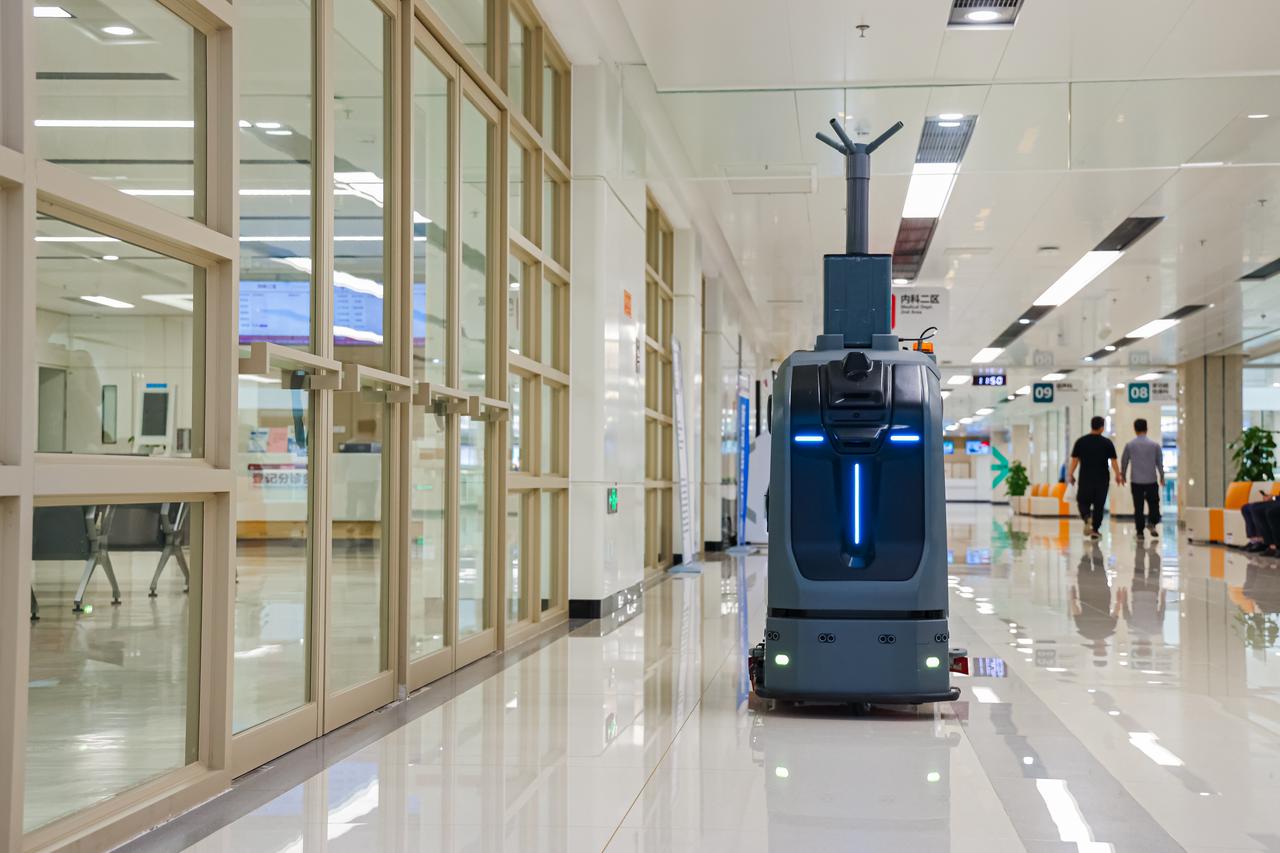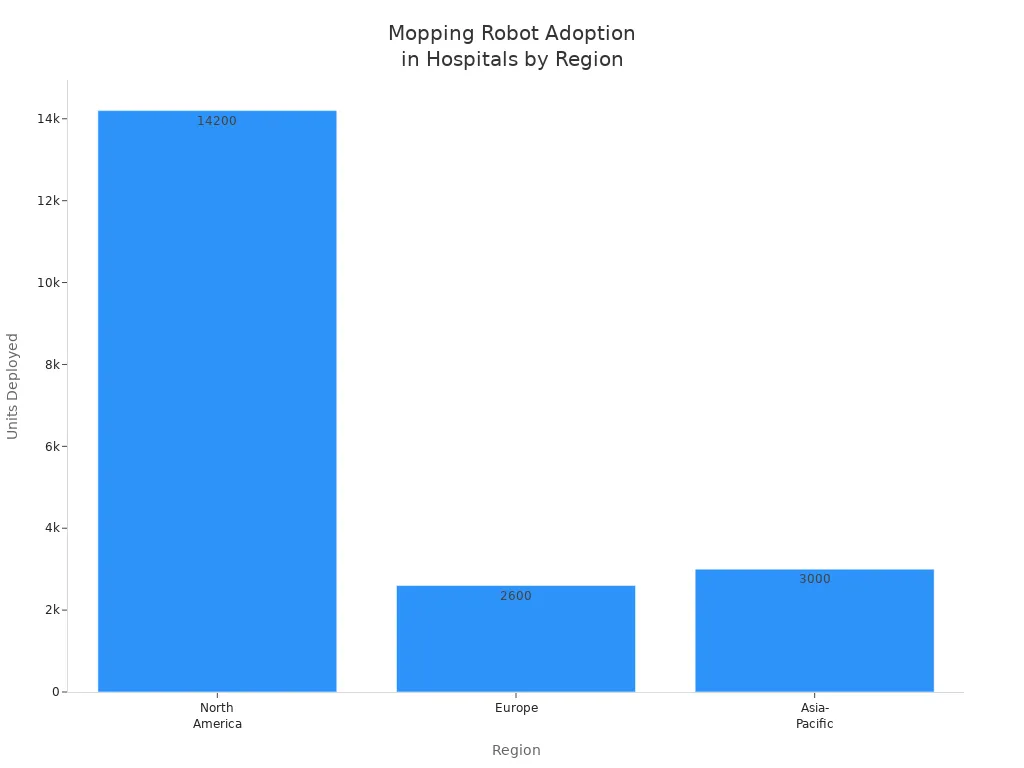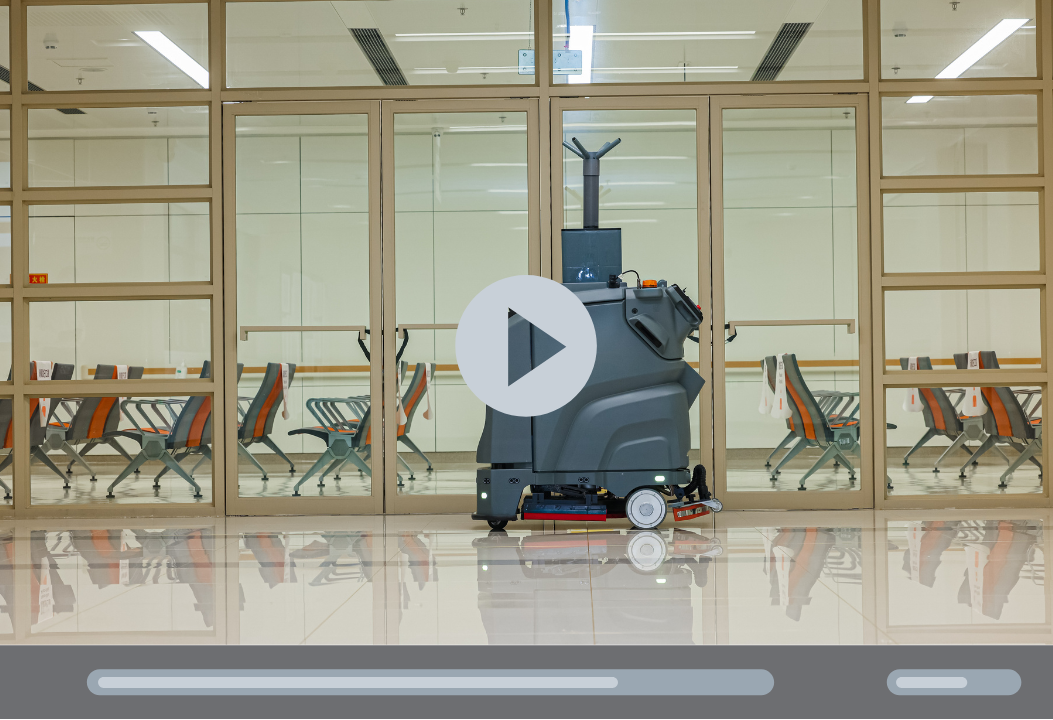
Hospitals use Commercial Mopping Robots to keep things clean and stop germs from spreading. These robots do not need mop water or buckets. They use Disinfectant Foggers, UV-C light and HEPA filters to kill bacteria and catch tiny particles in the air. Studies say these machines can lower cross-contamination by up to 90%. This helps keep patients and staff safe. Hospitals all over the world have more than 11,000 robots. North America and Asia-Pacific have the most robots.

Cross-Contamination Risks
Hospital Environment
Hospitals always have to worry about cross-contamination. Germs can live on many things people touch a lot. Bed rails, door handles, and medical equipment often have bacteria and viruses. These germs can stay there for hours or even days. If cleaning is not done well, or if dirty mops or wipes are used, germs can spread more.
Note: Healthcare workers' hands and clothes can move germs around. Even after cleaning, if staff do not follow hygiene rules, they might spread bacteria to patients or other places.
Some common ways germs spread in hospitals are:
-Patients, especially those already sick or infected
-Dirty medical tools and equipment
-The hospital itself, like floors, curtains, and furniture
-Healthcare workers' hands, gloves, and gowns
-Rooms that had infected patients before
Some parts of the hospital are at higher risk. The table below shows these areas and why they are more likely to have problems:
| Hospital Area | Reasons for Susceptibility |
| Patient Rooms | Lots of care and hand contact; hand washing is very important |
| Operating Room | High risk during surgery; needs strong infection control |
| Sterile Processing Dept. | Dirty tools can spread germs; mistakes in cleaning can cause problems |
| Physical Plant | Dirty linens and surfaces; needs careful cleaning |
| Kitchen | Food mistakes and cross-contact; risk is higher for weak patients |
Infection Dangers
Cross-contamination in hospitals can cause serious health problems. The most common infections are from antibiotic-resistant bacteria like MRSA and VRE. Other dangerous germs include Acinetobacter baumannii, Klebsiella pneumoniae, Clostridioides difficile, Candida albicans, Pseudomonas aeruginosa, and Escherichia coli. These germs often spread by touching dirty surfaces, medical devices, or healthcare workers' hands.
Patients who get infections from cross-contamination stay in the hospital longer and pay more money. For example:
| Measure | Patients with HAIs | Patients without HAIs | Difference |
| In-hospital mortality rate | 14.70% | 7.80% | 0.069 |
| Average length of stay (days) | 18.85 | 10.59 | +8.3 days |
| Average total cost (ETB) | 4826 | 1793 | 3033 |
Healthcare workers and outside staff can also get exposed. They might carry germs between hospital areas or even to other hospitals. This makes outbreaks more likely and infection control harder. Hospitals must use strict cleaning and new technology to keep patients and staff safe.
Traditional Mopping Issues
Human Error
Manual mopping in hospitals does not always clean well. Staff have different skills and ways of cleaning. Some spots get missed or not cleaned right. Only about 40%of near-patient surfaces are cleaned as rules say. This means 60% might still be dirty after cleaning. People get tired,distracted, or do not have enough supervision. These things make mistakes happen more often. Even good staff can mess up when they are busy.
Note: Human mistakes can leave half the hospital dirty. One study found 25% of rooms still had bad bacteria after several cleanings.
Manual mopping takes a lot of time and hard work. Staff must carry heavy buckets and push big carts. They have to wring mops into dirty water again and again. This spreads germs more easily. These jobs can hurt backs and wrists. Cleaning slowly can bother patients and make them less happy.
| Limitation | Explanation |
| Cross-contamination risk | Mop dirt and germs move from room to room with reused mops and dirty water. |
| High water usage | Each staff member uses about 21 gallons of water per shift because buckets need changing often. |
| Frequent wringing required | Mops get wrung out many times in dirty water, which spreads germs. |
Contaminated Tools
Old-style mops and buckets can spread germs. If mop pads are not washed in hot water, they keep germs. Staff who touch dirty mop pads can get germs on themselves. Not cleaning tools right can cause outbreaks and trouble with rules.
Research says cotton mops take away about 68% of germs. Microfiber mops do better and remove up to 95%. But if staff use the same mop head or do not change water, germs can go from room to room. Throw-away mop pads help stop this by not moving dirty pads around.
Hospitals must follow cleaning rules from OSHA and the CDC. Not cleaning tools right can cause bad infections and even fines. Sometimes, bad cleaning has made surgeries late and put patients in danger. Hospitals need good cleaning ways to keep everyone safe.
Commercial Mopping Robots in Hospitals
Advanced Cleaning Tech
Commercial Mopping Robots help hospitals stay clean and safe. These robots do not use old mop water or buckets. They have smart cleaning heads and automatic systems. The robots fill up with clean water and get rid of dirty water by themselves. They also add cleaning chemicals in the right amounts. This keeps staff from touching dirty water or mop pads. It lowers the chance of cross-contamination. The robots have filters that let them use water again. This means they use less water, dropping from 50 gallons to only 5 gallons for big spaces. This saves water and helps the environment. It also makes cleaning faster and safer.
Many hospital robots now include Disinfectant Foggers to go beyond basic floor cleaning. These foggers spray a fine mist of disinfectant into the air and onto surfaces, helping to eliminate viruses,bacteria,and fungi. This provides an extra layer of sanitation, especially in high-risk areas like operating rooms or isolation wards. The fog is able to reach corners and areas that traditional tools may miss, improving disinfection results significantly.
Note: The Disinfectant Fogger accessory, newly launched by Sparkoz for the TN-70 robot, is designed to address concerns about widespread surface and airborne contamination, especially in times of pandemic. It provides full-area coverage without direct human involvement.
Consistent Results
Commercial Mopping Robots always clean the same way every time. Manual cleaning depends on how careful staff are. Robots follow set paths and cleaning plans. This means every spot gets cleaned well each time. Robots can clean busy areas often and keep things clean all day.
-Robots use special cleaners to stop cross-contamination.
-Sensors help robots avoid bumping into things and cover all areas.
-Managers can check real-time data to make sure cleaning is done.
Manual cleaning sometimes misses important spots. Robots follow marked routes and do not skip places. One robot can clean 300 square meters in one go. This is quick and does not need much help. Robots also help staff by doing hard work. This means staff are less tired and make fewer mistakes.
Cleaning robots do boring and risky jobs. This stops mistakes from tired workers. Staff can spend more time on important infection control work. This makes hospitals safer and cleaner.
Robots work on their own and do not need much watching. They use sensors, cameras, and smart programs to move and clean carefully. This lowers the risk of spreading germs and making mistakes. Robots can check themselves for problems and fix small issues. This keeps them working well. Using robots makes hospital cleaning faster, safer, and more reliable.
See the demo: https://youtube.com/shorts/Ht5Fxs8EySw?feature=share

Effectiveness and Results
Pathogen Removal Rates
Commercial mopping robots clean hospital floors very well.
Studies show they can remove up to 99% of dirt and microbes from hard surfaces. When paired with Disinfectant Foggers, these robots can reduce harmful pathogens on surfaces and in the surrounding air by over 99.9%—in just a short amount of time. This far outperforms manual mopping methods.
Some robots also include HEPA filters, which can trap over 70% of airborne contaminants. The combination of airborne and surface disinfection leads to cleaner environments for both patients and staff.
Tip: Hospitals can program robots to disinfect high-risk zones more frequently using fogging features, keeping contamination risks low throughout the day.
Real-World Outcomes
Hospitals using commercial mopping robots see big changes. For example, Cameron Memorial Community Hospital used UV-C robots in operating rooms and busy halls.Infection rates went down a lot and cleaning got better. Staff spent less time cleaning by hand and more time helping patients. This made them safer from germs and kept everyone safer.
Many hospitals see the same results:
-Robots lower infection rates and help staff feel better about cleaning.
-Robots clean by themselves, so there are fewer mistakes and every spot gets cleaned.
-Staff and patients feel safer,even during outbreaks like COVID-19.
A new survey showed hospitals using these robots had up to 90% fewer cross-contamination problems. The robots move on their own and use safety sensors. They do not replace cleaning staff but help by doing boring and risky jobs.
Hospitals that buy smart cleaning robots make new rules for stopping infections and keeping staff safe. These results prove that technology can help hospitals stay clean and safe for everyone.
Benefits of Commercial Mopping Robots
Labor Savings
Commercial Mopping Robots help hospitals save time and money. These robots clean floors faster than people. They make work easier for cleaning staff. Workers can spend more time helping patients. Rosiwit Cobotics says their robots make cleaning 80% better in hospitals. This means staff do not spend as much time on simple cleaning. They can do jobs that need people instead.
Hospitals use robotic floor scrubbers to do the hard cleaning. Staff can then clean things people touch a lot. These places spread germs more easily. Robots work well and often clean at night. This way,they do not bother patients or staff. Robots help when there are not enough workers. They also help when hospitals are very busy.
-Robots clean big spaces fast.
-Staff can clean patient rooms and important areas.
-Hospitals save money by using less cleaning time.
Cleaning robots help hospitals plan cleaning better and get more done.
Compliance
Hospitals must follow strict infection control rules. Commercial Mopping Robots help them meet these rules. Studies show that AI disinfection robots kill 99.9% of common germs fast. Robots use sensors to see objects and people. This helps them clean safely and well.
Some hospitals, like JiaXin Hospital in the east-south of China, uses Sparkoz TN70-Pro robots with fogging systems. These robots clean almost every surface. They always clean the same way. This helps hospitals follow infection rules and pass checks.
Robots also help hospitals use fewer chemicals and less power:
-Robots work two shifts every day, all week, without using more energy.
-They use less power than old cleaning machines.
-Robots control how much cleaning chemical is used, so nothing is wasted.
-Floors dry faster, which saves energy and keeps people safe.
Hospitals with robots look cleaner and safer. This makes patients and staff trust the hospital more.
Commercial Mopping Robots help hospitals stay cleaner and safer. They lower the spread of germs and make hygiene better. These robots Disinfectant Foggers and smart technology to clean well every time. Hospitals have fewer infections and everyone is safer.
-Robots keep staff safe from germs and strong cleaning chemicals.
-They clean rooms by themselves, so people are not exposed.
-Cleaning gets done faster, which helps staff feel less tired.
-Hospitals can keep high hygiene standards and protect patients.
Experts say hospitals should use robots that work with staff and move on their own. Hospitals need to buy these robots to follow strict hygiene rules and keep everyone safe.
FAQ
How do commercial mopping robots avoid spreading germs?
Commercial mopping robots use new cleaning solution each time. They keep clean and dirty water apart. Many robots use disinfectant foggers to kill bacteria in the air. This helps stop germs from moving to other places.
Can robots clean all types of hospital floors?
Most commercial mopping robots work on hard floors like tile and vinyl. Some advanced robots can change settings for different floors. Hospitals should check what floors the robot can clean before using it.
Are commercial mopping robots safe to use around patients?
Yes. Hospitals use robots with safety sensors and quiet motors. Robots stay away from people and things in their way. Staff can set cleaning times when fewer people are around. This keeps patients safe and comfortable.
How often should hospitals run mopping robots?
Hospitals make cleaning plans based on how busy areas are and infection risk. High-risk places may need cleaning more than once a day. Robots can clean at night or between shifts for best results.
Do commercial mopping robots replace cleaning staff?
Robots do not take the place of staff. They do the same floor cleaning over and over. Staff can clean things people touch a lot and help patients. Working together makes hospitals cleaner and safer.